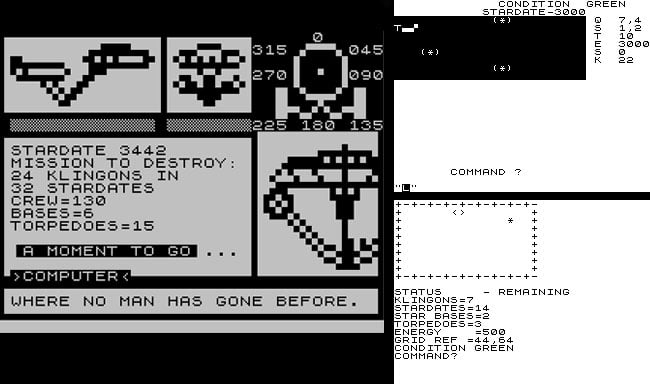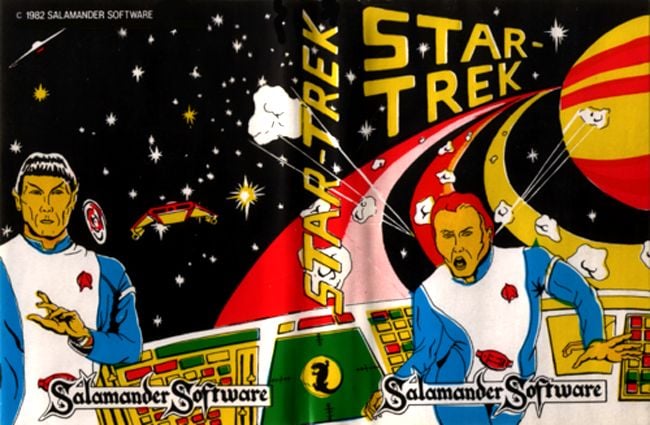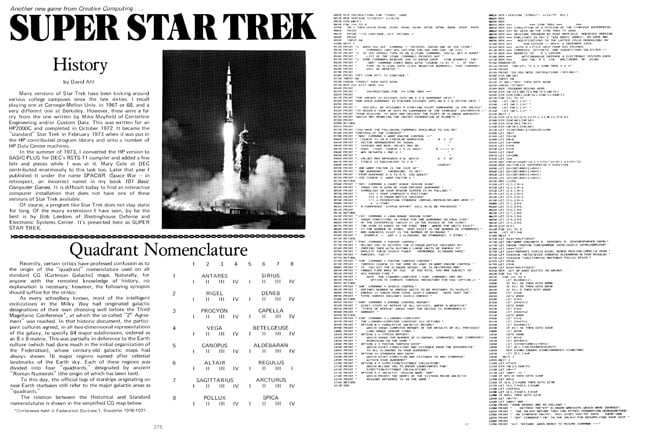This article is more than 1 year old
Star Trek: The original computer game
Into darkness: back to the 1970s, Basic and Ascii art
Boldly going 8-bit
This helped the game’s spread in the mid-1970s too. In 1973, David Ahl published Star Trek - this time under the name Space War - in a book, 101 Basic Programs. That inspired Bob Leedom to convert it to Data General’s dialect of Basic so he could run it on his workplace’s Data General Nova 800, which was free to use after office hours. He too tweaked the gameplay, in part on the back of suggestions made by colleagues who got to play it too.
Leedom wrote about his version in a Menlo Park-based newsletter, People’s Computer Company. Ahl saw the article, asked Leedom for a copy of the listing and published it in 1974 under a joint byline in his magazine, Creative Computing. He called it Super Star Trek, thanks to the improvements leedom had made In 1978, Ahl wrote a Microsoft Basic version and put in that year’s edition of his book Basic Computer Games.
Meanwhile, Mayfield’s original Sigma 7 version was replicated in other languages, as Ahl had done with Basic. David Matuszek and Paul Reynolds created a DEC Fortran version also called Super Star Trek, but otherwise unconnected to Leedom’s code, and Eric Allman produced BSD Trek in C - it's still available to download and run. In 1976, Lynn Cochran produced a version written in MITS Basic that was popular with Altair 8800 users.
But it was Ahl’s Basic Computer Games that spread Star Trek through US schools and colleges. Many programmers adapted the book’s listing to new platforms and Basic dialects: for OS-8 Basic, for Tiny Basic, for DEC’s RSTS-11 Basic and more. As new languages have emerged and new UIs evolved Star Trek has been adapted to them, a more sophisticated equivalent of ‘Hello World’ - an application to try on each new system you get. Sometimes the Ascii characters get replaced with sprites, even 3D ones; at other times new ports are true to the originals, but it has never quite gone away. Even in an era of big-brand games cashing in on the new film releases.
All of the versions that derive from Mayfield’s original share the same core gameplay. The galaxy is divided into 64 quadrants or sectors, each identified by a numerical grid reference and populated with randomly generated stars. A fleet of Klingon warships is dropped in to find and fight, and there are a sprinkling of Federation starbases where the Enterprise can refuel and stock up on photon torpedoes.

ZX Trek: Sinclair computers had many versions of the game
You warp your ship from quadrant to quadrant, employing long-range sensors to help work out where to go next, and using your short-range sensors - the main UI - to display the contents of surrounding space as a grid of Ascii characters. Enter commands to move, scan, fire phasers or launch torpedoes, and if you play the game right you can clear the cosmos of Klingons, don’t get too damaged or run out of energy, and still be home in time for tea. If you took too long to complete your mission, you lost the game.
Mayfield’s original version used numeric commands - 2 for long range scans, 4 to fire a torpedo, 7 to get ship status, for example - but Leedom’s Super Star Trek added three-character command words: ‘LRS’, ‘TOR’ and ‘COM’, to use the above examples. It also introduced Klingon ships that would move to a new location in the quadrant if not destroyed outright. Later versions animated the flight of torpedoes. Many adopted another Leedom innovation: named quadrants.

Was there a platform that didn’t have a version of Trek?
And iffy tape inlay artwork...
That encouraged the use of torpedoes over phasers - which often didn’t do enough damage without overly depleting your own ship’s energy levels. Why risk miscaculating your phaser fire when it was easier - and quicker - to move to a better firing position and let rip with a torpedo guaranteed to hit and destroy the enemy.
Like most games of the period it was fun to play once or twice, but it lacked staying power. And if its graphics and gameplay are woefully unsophisticated by today’s standards, well that’s the way most Basic games were in those days. And for the players, they were still a shiny new gateway to “strange new worlds”. ®
Pete Turnbull has a comprehensive list of early versions Star Trek, many with accompanying listings for readers with an interest in Basic.
Developer Mike Mayfield
Publisher None: public domain
Platforms Pretty much all of them

